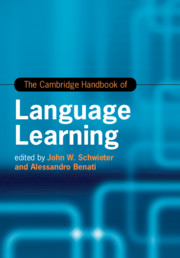Book contents
- The Cambridge Handbook of Language Learning
- Cambridge Handbooks in Language and Linguistics
- The Cambridge Handbook of Language Learning
- Copyright page
- Contents
- Figures
- Tables
- Contributors
- Acknowledgements
- Introduction
- Part I Theories
- Part II Methods
- Part III Skill Development
- Part IV Individual Differences
- Part V Pedagogical Interventions and Approaches
- 20 Pedagogical Interventions to L2 Grammar Instruction
- 21 Task-Based Language Learning
- 22 Task and Syllabus Design for Morphologically Complex Languages
- 23 Proficiency Guidelines and Frameworks
- 24 Technology-Mediated Language Learning
- 25 Content-Based L2 Teaching
- 26 Conceptions of L2 Learning in Critical Language Pedagogy
- Part VI Context and Environment
- Part VII Moving Forward
- Index
- References
23 - Proficiency Guidelines and Frameworks
from Part V - Pedagogical Interventions and Approaches
Published online by Cambridge University Press: 25 June 2019
- The Cambridge Handbook of Language Learning
- Cambridge Handbooks in Language and Linguistics
- The Cambridge Handbook of Language Learning
- Copyright page
- Contents
- Figures
- Tables
- Contributors
- Acknowledgements
- Introduction
- Part I Theories
- Part II Methods
- Part III Skill Development
- Part IV Individual Differences
- Part V Pedagogical Interventions and Approaches
- 20 Pedagogical Interventions to L2 Grammar Instruction
- 21 Task-Based Language Learning
- 22 Task and Syllabus Design for Morphologically Complex Languages
- 23 Proficiency Guidelines and Frameworks
- 24 Technology-Mediated Language Learning
- 25 Content-Based L2 Teaching
- 26 Conceptions of L2 Learning in Critical Language Pedagogy
- Part VI Context and Environment
- Part VII Moving Forward
- Index
- References
Summary
In the decades following the Second World War, there was a strongly felt need on both sides of the Atlantic to find ways of describing L2 proficiency in terms of functional capacity—the ability to perform communicative tasks in the real world—rather than grammatical knowledge. In the wake of wars against Japan and Korea, the United States government wanted to be able to gauge what its employees could do in the L2s they had learnt; in Europe, a major challenge was to enable adult language learners to develop communicative repertoires sufficient to support mobility. This chapter focuses on the two most influential instruments to emerge from this reorientation of L2 education, the Proficiency guidelines developed by the American Council on the Teaching of Foreign Languages (ACTFL PG; ACTFL, 1986, 2012a; Breiner-Sanders et al., 2000; Breiner-Sanders, Swender, & Terry, 2002) and the Council of Europe’s Common European framework of reference for languages (CEFR), originally published in the organization’s two official languages, English and French (Council of Europe, 2001a, 2001b).
- Type
- Chapter
- Information
- The Cambridge Handbook of Language Learning , pp. 550 - 574Publisher: Cambridge University PressPrint publication year: 2019
References
- 1
- Cited by

